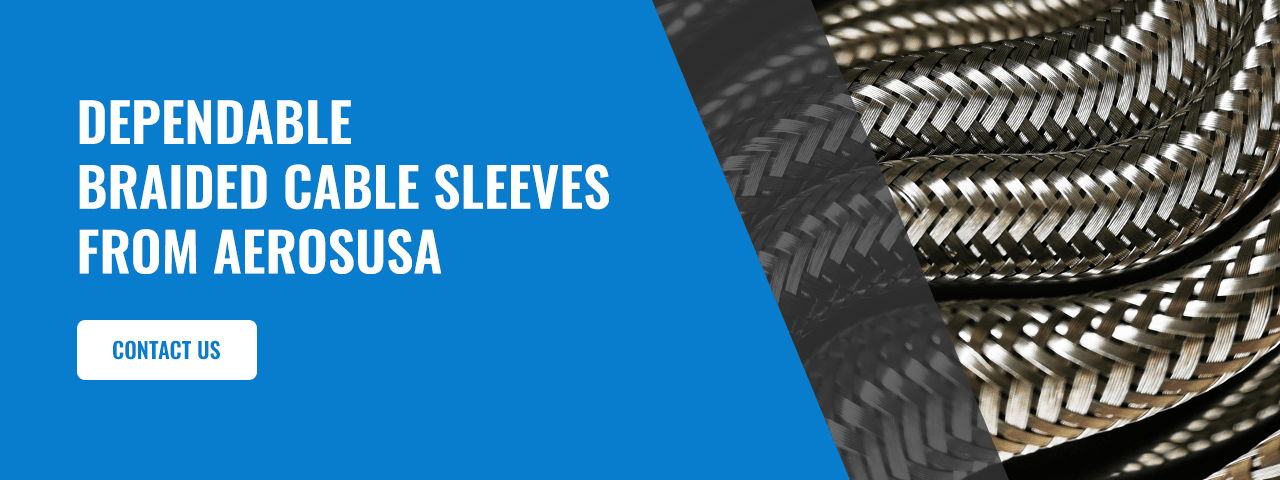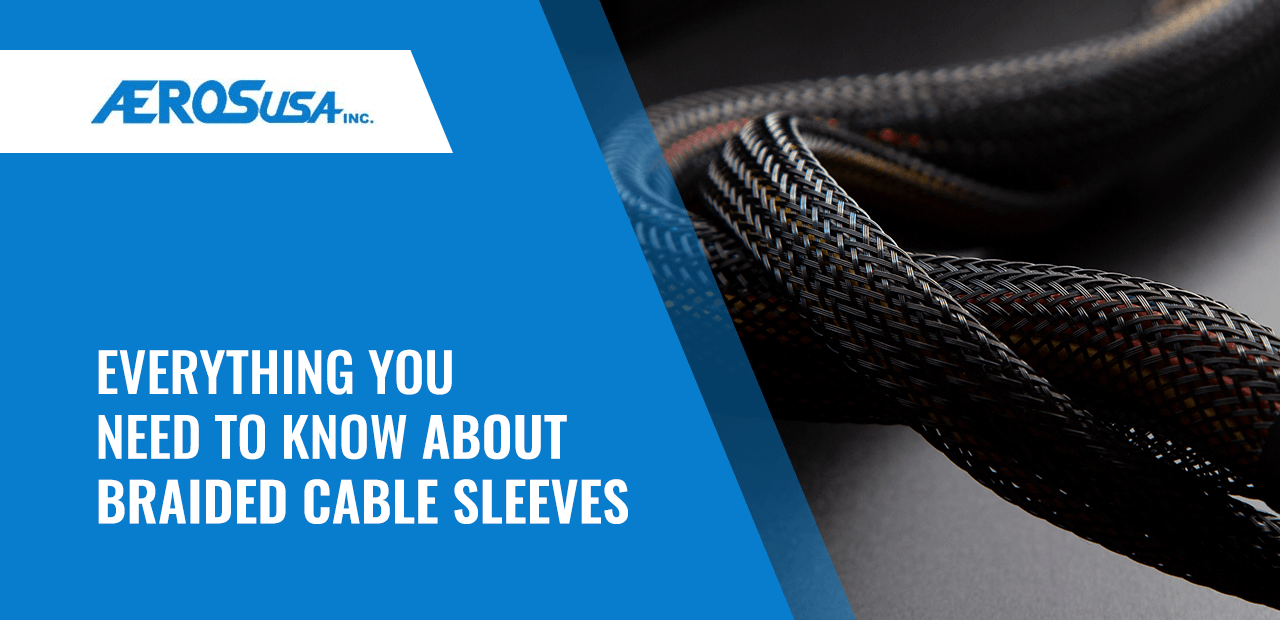
If your industry relies on electrical cables, you likely require dependable cable protection. With so many products on the market, making the right choice can be complicated.
When you’re considering braided cable sleeves, for instance, you’ll want to understand how they work, what protections they offer and the conditions and applications for which they are most suitable. We’ve compiled this guide to give you a comprehensive picture of braided cable sleeve uses and benefits, as well as a few tips for choosing the right size and sealing the sleeves properly.
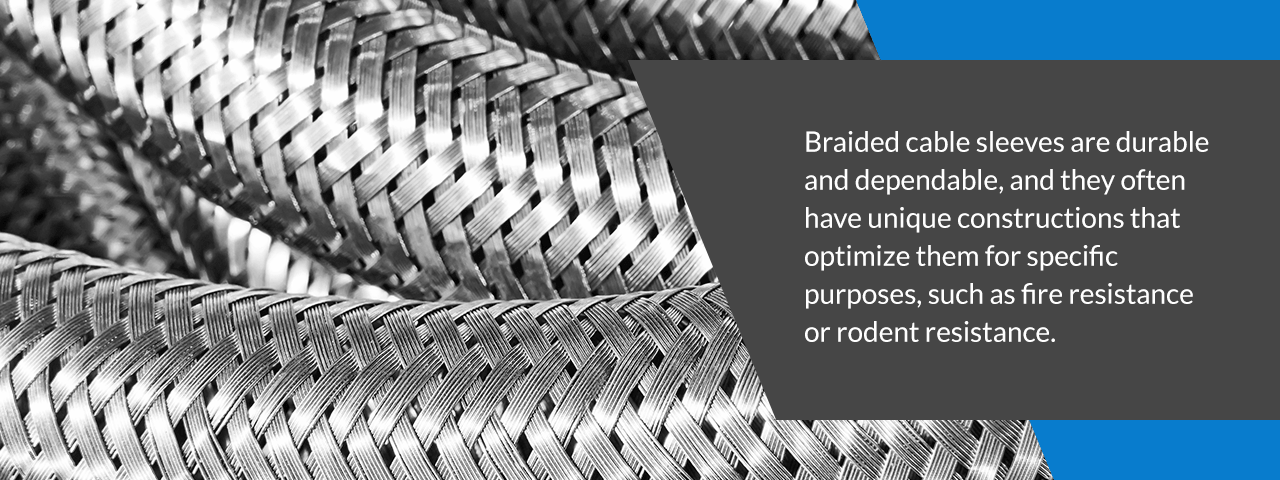
| All Braided Cable Sleeve Resource Pages: |
| Page 1 – Braided Cable Sleeves Guide |
| Page 2 – High Temperature/Heat Resistant Braided Sleeve FAQs |
| Page 3 – Importance of Rodent Resistant Braided Sleeving |
What Is a Braided Cable Sleeve?
A braided cable sleeve, also known as a wire protection sleeve, is a cable organizer and protector. These sleeves often contain braided plastic fibers, usually woven polyester or another plastic, though metal braided cable sleeves are also options.
What is a braided cable sleeve used for? These helpful products shield the wires and cables in industrial applications. They offer superior protection against corrosion, abrasion, heat, moisture, chemicals and electromechanical waves.
Unlike many other cable protector options, which often consist of smooth, unbroken plastic or metal, braided cable sleeves have a relatively open weave. This construction offers several advantages. It dissipates heat easily through the openings and lets moisture evaporate away quickly. It enables superior flexibility and allows employees to examine the cables easily for damage when they need to.
Braided cable sleeves are durable and dependable, and they often have unique constructions that optimize them for specific purposes, such as fire resistance or rodent resistance. They provide excellent protection for the cables used in even the toughest, most heavy-duty industrial environments.
What Materials Are Used in Braided Cable Sleeves?
Different types of plastic fibers frequently compose protective sleeving. Here are several materials commonly used in braided cable sleeves, along with some of their advantages and disadvantages:
1. Nylon
Nylon sleeving is a braided monofilament sleeving, and it is advantageous in cable protection because of its lightness and flexibility. These properties make nylon sleeves easy to install, as well as easy to adjust to suit your unique operational needs and machine requirements. Nylon braided cable sleeves conform to different shapes and sizes easily, so you can protect your cables even if they differ in size or have irregular shapes. These sleeves are ideal for applications requiring a high degree of flexibility, such as the wire harnesses used in the automotive industry.
Nylon also offers effective abrasion resistance, so it is highly suitable for use in cable assemblies and automotive applications, where cables regularly undergo excessive wear and tear. It is also highly effective at rebuffing moisture. Many companies use nylon braided sleeving when they need proven protection against water damage, which can cause functional issues, breakdowns and fires. It is a go-to material for wet applications involving cables.
Because nylon braided sleeving protects against a wide range of environmental stressors, it is beneficial in many demanding industrial environments. It provides less temperature stability than some other options, though, and it offers limited chemical, corrosion and ultraviolet (UV) radiation resistance.
2. Polyester
Polyester braided cable sleeving distinguishes itself with its excellent abrasion resistance and its high overall thermal and mechanical protection. It is immensely flexible and can expand to three times its initial volume to fit easily over oversized and irregularly shaped cables. It also offers excellent insulation.
Polyester derives much of its appeal in industrial applications from its superior resistance to corrosion and high temperatures. These properties make polyester braided cable sleeves strong choices for applications such as electronics and some automotive applications. Polyester braided cable sleeves are less stable than other options at extremely high temperatures, and they offer limited chemical and UV resistance.
3. Polyethylene Terephthalate (PET)
Polyethylene terephthalate is a specific type of polyester. It’s lightweight and flexible, similar to nylon. PET braided cable sleeves are straightforward to install and highly adaptable for different cable shapes and various uses.
Polyethylene braided sleeving is well known for its longevity and superior water and fluid resistance. In applications where cables will become exposed to cleaning chemicals and automotive fluids like gasoline and engine fluids, PET is often a natural choice. PET is also highly resistant to abrasion, high temperatures, UV rays and high impacts. It helps relieve strain in stretched cables, preventing cracks and breakage and ensuring a longer life span.
PET is also unique because it has exceptionally high expansion potential. It.can expand to up to three times its initial diameter to fit easily over large or irregularly shaped cables.
As with nylon sleeves, polyethylene braided sleeves are beneficial across a broad range of challenging industrial applications because they offer comprehensive protections against environmental and operational stressors. However, PET sleeves come in several different varieties, so you’ll need to check your options carefully to ensure the right fit for your operations. They also offer more limited corrosion resistance than many other options.
4. Polyphenylene Sulfide Monofilament (PPS)
Even among generally lightweight braided cable sleeve varieties, PPS is incredibly light. It stands up to solvents and other chemicals exceptionally well and is common in the braided sleeves used for cable assemblies that require high temperature and flame resistance.
PPS’s high chemical resistance, moisture resistance, stability at high temperatures and exceptional wear resistance make it ideal in sensitive applications like those in the telecommunications and aerospace industries. Inertness to fuels, acids, strong bases and steam also makes PPS braided cable sleeves go-to choices in applications involving exposure to these substances. However, PPS is less flexible than many other alternatives, and it provides only limited UV protection and corrosion resistance.
5. Nomex
Nomex braided cable sleeves are lightweight and highly expandable, and they are notable for their impressive flame and heat resistance. They provide superior protection against chemicals, solvents, moisture and abrasion, and they have an exceptionally high melting point.
Nomex also offers impressive resistance to radiation, including X-ray, beta and gamma radiation, and it is resistant to certain types of acids. However, it is less flexible than many other types of braided cable sleeves and offers only limited corrosion resistance and UV protection.
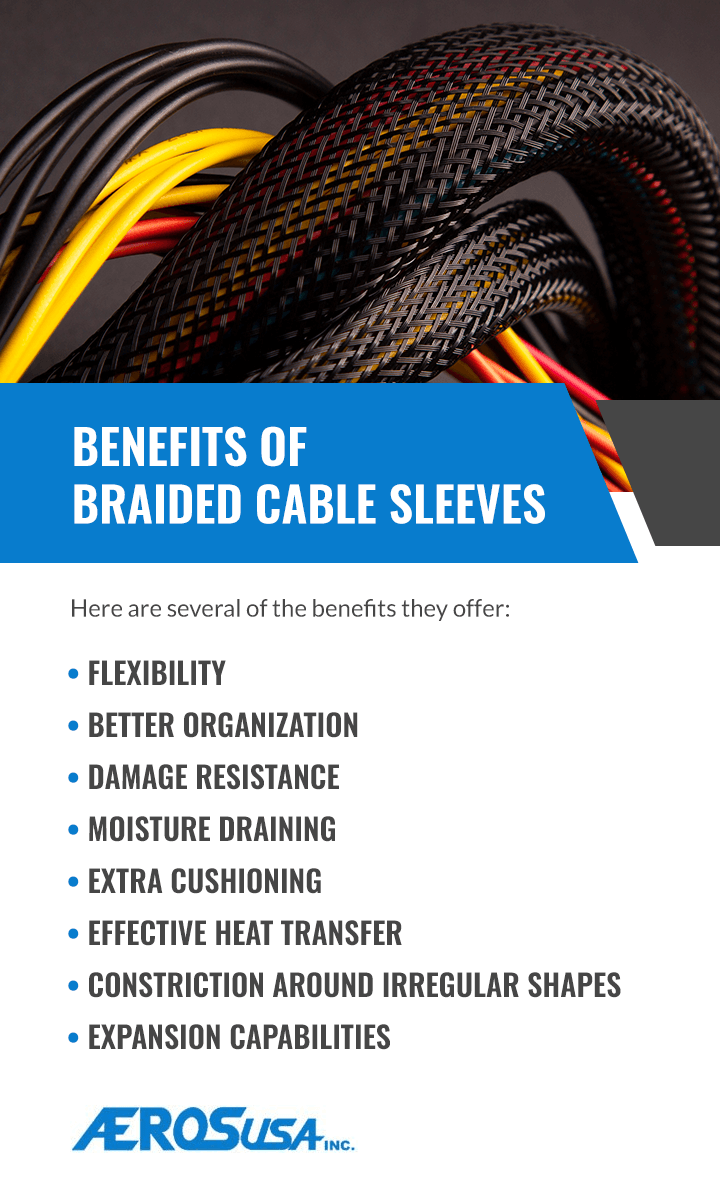
Benefits of Braided Cable Sleeves
Braided cable sleeves are advantageous for use in numerous commercial and industrial applications. Here are several of the benefits they offer:
- Flexibility: As we’ve discussed, most braided cable sleeves are highly flexible, especially compared with alternatives like metal conduits, which have their own pros and cons. They can easily fit into tight spaces, snake through complex equipment configurations and conform to varying cable shapes and sizes.
- Better organization: Braided cable sleeves enable a business to keep its many cables more organized. They collect a sprawling maze of wires or cables into a neat, compact sheath that improves the professional look of a workspace. They also help your company save time by quickly identifying which cables go where.
- Damage resistance: Durable braided cable sleeves protect cables from cuts and abrasions. Their sturdy construction allows them to stand up to more vigorous mechanical stresses than wires or cables alone.
- Moisture draining: Braided sleeves assist with moisture draining because of their open-weave construction. Moisture easily slips through the weave instead of collecting around the cables and potentially causing water damage, shorts and fires.
- Extra cushioning: Sturdy, tightly conforming braided sleeves provide cushioning to protect the cables inside from shock damage. They are invaluable in applications where vibrations and heavy impacts are expected.
- Effective heat transfer: Braided cable sleeves assist with heat transfer through their open-weave construction as well. Heat that collects around the cables can dissipate efficiently through the loose weave instead of building up and potentially causing electrical issues or fires.
- Constriction around irregular shapes: Braided sleeves’ flexibility means they constrict tightly even around irregular cable shapes. They provide effective cushioning and protection without creating gaps that could collect moisture or allow for damage.
- Expansion capabilities: The tremendous expansion ratios of many braided cable sleeves mean they accommodate large cables. These sleeves are ideal for jumbo-sized cables that might not fit correctly in more rigid cable protection.
Where to Use Braided Cable Sleeves
Braided cable sleeves are ideal for a wide range of industrial applications. Here are some industries that use braided cable sleeves:
- Marine: Because of their high performance in water and other fluids, braided cable sleeves are highly desirable in many marine and offshore applications. They are common in vessel engines, control panels and switchboards.
- Automotive: Similarly, because of their high performance around engine fluids and their abrasion resistance, braided sleeves are ideal for use in some automotive applications, including many hybrid vehicles. They are frequent components around the cables in engines and vehicle electronic systems.
- Military: In demanding military applications, braided cable sleeves are essential for their resistance to an array of environmental and operational stressors. They are useful in transport vehicles and many types of materiel.
- Robotics: The precise motions desired in robotics and automation necessitate highly flexible cable protection. Braided cable sleeves provide the required flexibility while offering superior resistance to conditions that could damage expensive, sensitive products.
- Manufacturing: The operational stresses on the machine tools used in manufacturing often necessitate cable protections. Braided cable sleeves’ durability, broad resistances and expandability make them ideal for use with heavy-duty equipment in this challenging environment.
- Power generation: Traditional power plants and renewable energy facilities rely on cable systems for dependable functioning. Especially in outdoor renewable operations, braided cable sleeves protect against UV radiation, dust, heat, water, wind and fire damage while providing essential flexibility.
- Rail transportation: In the rail transit industry, cables that hang down from the undercarriages of railcars become exposed to abrasions, vibrations, extreme temperatures and weather elements like wind and rain. Braided cable sleeves enable essential moisture drainage while providing flexibility and protecting against mechanical and environmental stresses.
- Mining and heavy construction: The equipment used in mining and heavy construction applications faces exposure to harsh UV radiation, dust, extreme temperatures, moisture, chemicals, fluids, powerful impacts and vibrations. Braided cable sleeves offer comprehensive resistance to these stressors, even in demanding mining and construction environments.
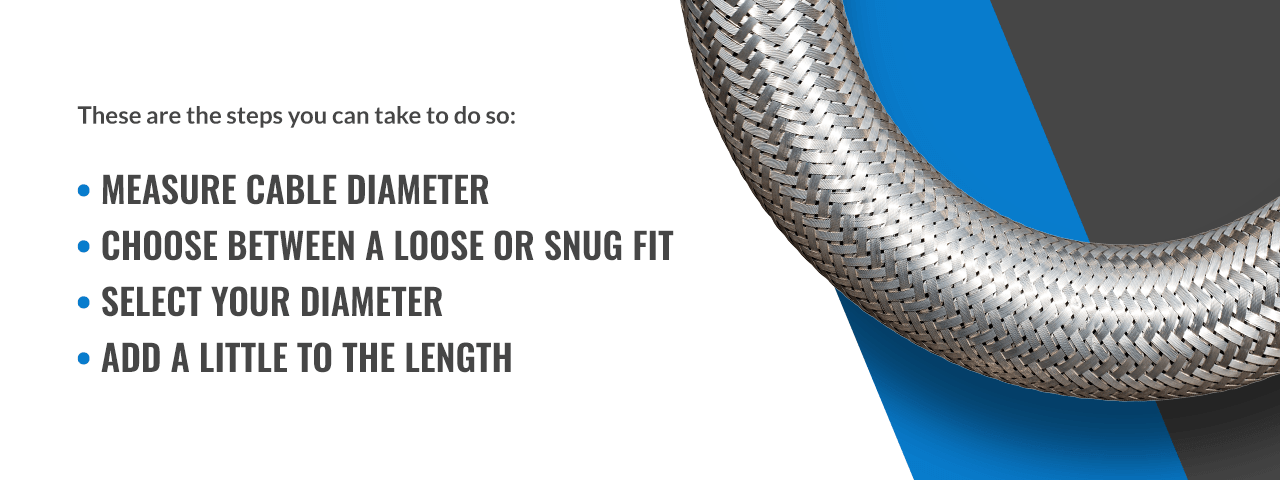
Determining the Right Cable Sleeve Size
To provide the best protection for your cables, you’ll need to select the correct cable sleeve size. These are the steps you can take to do so:
- Measure cable diameter: First, measure the cable you need to cover. You’ll want to be relatively precise with this minute measurement.
- Choose between a loose or snug fit: Next, figure out how you’d like the cable sleeve to fit the cable. A snug fit provides more cushioning, while a looser fit enables greater flexibility.
- Select your diameter: For a snug fit, choose a diameter slightly smaller than the diameter of the cable bundle. For a loose fit, choose a diameter slightly larger than that of the cable bundle.
- Add a little to the length: Braided cable sleeves can contract slightly in length when they expand in diameter. You may want to add a few millimeters to the length of the cable when you’re calculating the sleeve length.
Managing Braided Cable Sleeve Ends
You’ll need to manage the ends of your braided cable sleeves effectively to prevent them from unraveling during use. You can terminate the ends of your braided cable sleeves using a few different methods:
- Tape: Using electrical tape is generally the most efficient, cost-effective method for managing braided cable sleeve ends. After inserting the cable, wrap the ends of the braided sleeves tightly with electrical tape. For aesthetic consistency, match the tape to the braided sleeve color. This method is easy and economical, though the tape can sometimes be difficult to remove and is not usually suitable for reuse.
- Cable wraps: Cable wraps are another quick, effective way to secure sleeve ends. These Velcro wraps slide neatly onto the ends of the sleeves to hold them securely in place, and they are easy to color-match for a sleek, polished look. They come off more readily than tape and are easy to reuse if you need to move and resecure your cables.
- Shrink tubing: Heat-shrink tubing is more time-intensive to apply and more secure once the application is complete. To put on heat-shrink tubing, you’ll slide the length of plastic tubing down the cable and then apply heat to it with a blowtorch or heat gun. Automotive and aviation applications often employ this method because it provides heat protection and weatherproofing while securing the ends of the sleeves.
Dependable Braided Cable Sleeves From AerosUSA
To see the benefits of versatility and durable protection in challenging industrial environments, choose braided cable sleeves from AerosUSA. Our sleeves find uses across various industries because of their reliability, longevity and robust protection against mechanical, thermal, abrasion, chemical, UV and corrosion damage. We pride ourselves on responding to customer needs right away, and our team of expert professionals is happy to be your trusted advisors when you have questions about our products.
Contact us today to purchase braided cable sleeves or learn more.

